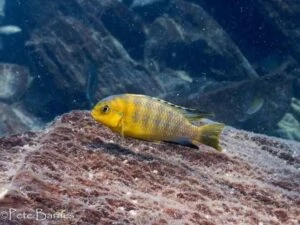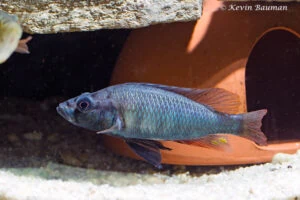Maskaheros argenteus
Maskaheros argenteus was scientifically described by Allgayer in 1991. The genus name Maskaheros is derived from ‘mascara’ and means mask. Heros comes from Latin and means Hero. The name Heros has also been widely used in the past as a generic name for neotropical cichlids. The species name Argentea is a reference to the color of this species, it means Silver.
Previously, this species was mainly known as Vieja argentea. Synonyms: Cichlasoma argentea, Vieja argentea, en Paraneetroplus argenteus.
Family
This species falls into the Cichlidae family or the cichlids. This family includes about 250 genera and more than 1700 species. New ones are added regularly. The genus Maskaheros has only two species: Maskaheros argenteus and Maskaheros regani.
Description
Maskaheros argenteus can reach a length of about 35 centimeters, the females remain slightly smaller. The Maskaheros argenteus has a silvery white ground color with many black dots, typical is the black frontal band and the stripe below it, which seems to run straight through its eyes. They also have a shoulder spot and a spot on the caudal peduncle. The gender distinction is difficult to see, the females are slightly smaller.
Maskaheros argenteus are quite calm and peaceful territorial fish, only young adults can be aggressive towards each other, as they get older this behavior disappears. They can be combined with other peaceful cichlids.
Origin
Rio Usumacinta, Rio Tulija, Rio Tonala, Mexico, Guatemala.
The Aquarium
Maskaheros argenteus requires an aquarium of at least 2 meters wide, 60 cm. deep and 50 cm. high. Furnish the aquarium with various pebbles and boulders, and also use driftwood roots to create sufficient hiding places. The substrate must consist of sand.
Water parameters
Temperature: 22-30 Celsius
pH: 7,5-8
GH: 12-16
Diet
They can be fed with a variety of food. They will eat both live and frozen food, such as mysis, krill, shrimp and mussels, and vegetable food such as spirulina should not be missed.
Breeding Maskaheros argenteus
Breeding the Maskaheros argenteus is quite difficult. It is best to start with a group of young fish from which couples will later form. Forming a pair is not too easy and it is best to start with a small group of 5, 2 males/3 females.
They deposit up to 1,000 eggs on a cleaned stone, after 3 days the eggs hatch, and after about a week the young swim around freely. The fry can be raised with brine shrimp nauplii.
Video
Author
Coby
Copyright images
Lee Nuttall
Brian Traas



















Reviews
There are no reviews yet.